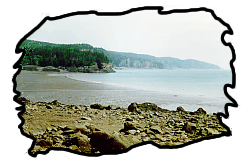|
|
|
|

Rockhounding in Nova Scotia
Geology of Nova ScotiaNova Scotia boasts a varied geological history spanning almost 1 billion years. On a former plate margin, the province is home to huge basalt flows thought to be related to the Palisades Disturbance of New York. The South Mountain Batholith forms the backbone of the province, the cores of the ancient Acadian Orogeny. The Atlantic coast is flanked in deep the sea sediments of the Meguma Formation. Laced with quartz veins, this region spawned a productive gold mining industry in the 1860's and some exploration and development continues today. To the north, vast thicknesses of carboniferous sediments host large coal reserves while older layers are exploited for their salt and gypsum deposits. Coal is also mined in Cape Breton. As well, the Cape Breton Highlands National Park rests on a plateau of highly deformed Precambrian rocks with a topography and scenery strikingly similar to that of the famous Scottish Highlands.
MineralsNova Scotia is best known for its zeolites found in the late Jurassic basalts of the North Mountain along the Bay of Fundy. A wide variety of minerals may be found in the veins and amygdaloids of this lava. There are two major areas for collecting here: the north shore of the Bay from Cap D'or through Parrsboro to Five Islands, and the eastern side of the bay from Cape Blomidon to Brier Island.
Also found on the north shore are heulandite, apophyllite, analcite, natrolite (Figure 3), mesolite, scolecite, native copper, barite, fluorite, amethyst and other quartz varieties, and uncountable varieties of agates and jaspers. Many of these form association specimens, with 4 or 5 five species commonly represented on a single piece.
CollectingRockhounding in this area is generally easy and open, but there are some guidelines to keep in mind if you've never collected minerals here before. Since these are shoreline exposures, collectors should limit their take to what can reasonably be carried. Commercial collecting is not permitted in most areas since this can seriously damage beach environments and lead to excessive erosion and loss of shoreline habitat. There are severe penalties for removing large amounts of material from beaches in Nova Scotia, ranging from fines to imprisonment. All responsible collectors will understand this and exercise restraint when visiting shoreline occurrences.Wasson's Bluff, near Parrsboro, is the site of rare dinosaur and primitive mammal discoveries, as well as the source of some of the finest chabazite known. Because the fossils represent such an important scientific resource, the area is protected under the Special Places regulations of the province. No material may be removed from the exposures along this stretch of coastline, either fossil or mineral. Collecting is permitted on a limited basis, but only from loose material at the base of the cliffs and only in quantities that can reasonably be carried in two hands (ie: one or two specimens). Talus does qualify as collectible material, but do not climb the slopes. Aside from being dangerous, this creates unnecessary erosion and can damage adjacent fossil beds. Collectors should consider Wasson's Bluff a hammer-free zone.
ActivitiesThere is a lot to do along the Parrsboro shore if you're interested in mineral collecting. The Fundy Geological Museum houses a fine representation of Nova Scotian minerals and fossils. The Parrsboro Rock Shop and Museum, run by Eldon and Elaine George is a must-see. The Georges have collected for years along this part of the Bay of Fundy and have many fine specimens on display and also for sale. If you're visiting in the middle of August, you'll arrive just in time to attend the Nova Scotia Mineral and Gem Show in Parrsboro. This is a great event with dealers, demonstrations, and field trips. If you are interested in any of these activities, just e-mail us at the Mineral City Exchange for details and dates.
Guided Field TripsMineral City Exchange offers guided field trips for individuals and groups to a variety of collecting localities in Nova Scotia. Let us know when you intend to be here and we'll be happy to send you information. Just e-mail us, or send your request by snail-mail to:
467 Glen Rise Drive Lower Sackville, NS Canada, B4E 2M4 Tel: (902) 865-2551 E-mail: wilson.minerals@ns.sympatico.ca
This article may not be copied, distributed or reprinted in any form without the author's permission. To contact the author, please use the e-mail address provided. If you are unable to contact the author, please contact the Canadian Rockhound. Authorized reprints must acknowledge the author and the Canadian Rockhound, and include the website URL address of the Canadian Rockhound. Document Number: CR9701307

Copyright ©1997 Canadian Rockhound
Images of minerals are Copyright ©1996
theImage.com
Magazine Issues |
News & Events |
Junior Rockhound |
Resources
|